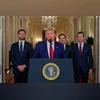US President Donald Trump has announced the imposition of a 25 per cent tariff on goods imported from Japan and South Korea, effective August 1, 2025, citing persistent trade deficits and “unfair” practices. The move, made under emergency economic powers, marks a sharp escalation in Trump’s protectionist trade stance and has triggered fresh concerns among economists and markets.
Trump made the announcement by posting letters addressed to Japanese Prime Minister Shigeru Ishiba and South Korean President Lee Jae-myung on his social media platform, Truth Social. In both letters, Trump stressed his commitment to the trading relationship but underscored the need for more balanced terms.
“It is a Great Honor for me to send you this letter in that it demonstrates the strength and commitment of our Trading Relationship, and the fact that the United States of America has agreed to continue working with Korea, despite having a significant Trade Deficit with your great Country,” he wrote in his letter to the South Korean President.
He continued, “We invite you to participate in the extraordinary Economy of the United States, the Number One Market in the World, by far.”
Warning against retaliation
Trump cautioned both countries against retaliatory measures, stating: “If for any reason you decide to raise your Tariffs, then, whatever the number you choose to raise them by, will be added onto the 25% that we charge.”
Also Read
He added that “there will be no Tariff if Korea, or companies within your Country, decide to build or manufacture product within the United States and, in fact, we will do everything possible to get approvals quickly, professionally, and routinely — In other words, in a matter of weeks.”
In a notable remark present in both letters, Trump also said, “These tariffs may be modified, upward or downward, depending on our relationship with your Country.”
Sectoral tariffs and broader application
According to the letters, the newly announced 25 per cent tariff will apply to goods not already covered under existing sectoral levies. Autos will continue to face the standard global tariff of 25 per cent, while steel and aluminium imports will be subject to a 50 per cent tariff. Goods routed through third countries to bypass the tariffs “will be subject to that higher Tariff,” Trump warned.
Trump justified the tariffs as a necessary measure to address what he termed as “longterm, and very persistent, trade deficits.” He emphasised that the $69.4 billion goods trade deficit with Japan and the $66 billion imbalance with South Korea, as recorded by the US Census Bureau in 2024, posed a threat to US economic interests.
“This deficit is a major threat to our economy and, indeed, our national security!” he declared.
He also noted that the tariff revenue would support the tax cuts he signed into law on July 4, a move his administration claims will help reduce the federal deficit. Critics, however, warn that the tariffs could pass costs onto middle- and lower-income consumers.
Market reaction and global concerns
The announcement has unsettled financial markets, with the S&P 500 index dropping nearly 1 per cent in afternoon trading and the yield on the 10-year US Treasury note rising to 4.39 per cent. Analysts warned that such developments could lead to higher mortgage and auto loan rates, potentially slowing economic growth.
Despite growing concerns of a global slowdown, Trump remains firm in his belief that tariffs will revive domestic manufacturing and reduce reliance on imports. “Please understand that the 25 per cent number is far less than what is needed to eliminate the trade deficit disparity we have with your country,” he wrote.
Negotiation window and future talks
Although the tariffs are set to take effect in about three weeks, Trump’s administration has indicated that this period could allow for continued negotiations with both countries. Earlier, a 90-day negotiating period had taxed imports at a baseline 10 per cent, and officials suggested the upcoming window may serve as an informal extension for talks.
Trump’s broader trade strategy has included efforts to renegotiate frameworks with other nations. A recent deal with Vietnam aims to block China from funnelling goods through the country, doubling the tariff on transnational imports from Vietnam to 40 per cent. A separate arrangement with the UK will impose a 10 per cent tariff on most British goods, while exempting certain items like steel and autos through quotas.
A broader strategic puzzle
Trump’s decision to target two of America’s closest allies in Asia while seeking to counter China’s economic influence has sparked strategic uncertainty. Observers note that alienating Japan and South Korea could weaken US efforts to contain Beijing’s regional ambitions.
Nevertheless, Trump appears undeterred, casting the new tariffs as a “remedy” for years of economic imbalance. With implementation fast approaching, all eyes are now on Washington, Tokyo and Seoul as the clock ticks on a potential new phase of tense trade negotiations.

)